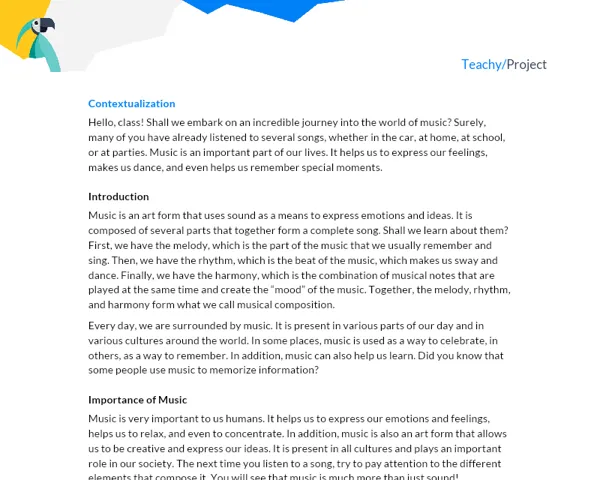Contextualization
Dance is a form of art that expresses itself through body movement. It has different forms and styles, depending on the culture and context in which it is performed. Dance can be used to tell stories, express emotions and feelings, celebrate special occasions, or simply to have fun and stay active.
Dance is not only a fun and interesting activity, but it is also a significant part of our culture and history. It is an expression of the human spirit and can give us a greater understanding of different cultures and societies.
Introduction
In this project, you will explore and learn about different forms of dance in various cultural and social contexts. This will involve more than just learning to dance - you will investigate the history, origin, and meaning of different types of dances, and how they are used and appreciated in different communities around the world.
First, let's start by learning about what dance is and why it is important. Dance is a form of communication that uses the body to express ideas and feelings. It is a fundamental part of many cultures and is used for many different purposes, from religious rituals to entertainment.
Next, you will research different styles of dance around the world, such as classical dance, traditional dance, folk dance, contemporary dance, and street dance. Each style of dance has its own unique characteristics, techniques, and traditions.
Finally, you will explore how dance is used in different contexts - for example, in the classroom, on stage, at festivals and celebrations, and even in protests and demonstrations. Each context brings different challenges and opportunities for dancers, and impacts how dance is performed and appreciated.
While this project may be challenging, I hope you also find it fun and rewarding. Along the way, you will develop valuable skills such as time management, communication, problem-solving, and creative thinking. Additionally, you will have the opportunity to experience and appreciate different forms of dance and begin to understand how dance fits into our diverse and dynamic world. Let's get started?
Practical Activity: 'Dances Around the World'
Project Objective
The objective of this project is to research, appreciate, and present different styles of dances from various parts of the world.
Detailed Project Description
In this project, student groups will first research different styles of dance from various cultures. They will learn about the history of the chosen dance, its distinct movements, music, costumes, and how it is used in its original culture.
Next, students will prepare a presentation to share their findings with the class. The presentation should include an explanation of the dance, a demonstration of some of its movements, and, if possible, a small performance of the dance.
Required Materials
- Books or internet for research.
- Proper dance attire.
- Space to practice and present the dance.
- Appropriate music for the chosen dance (can be found on the internet or on CDs).
Step-by-Step for Activity Execution
- Form groups of 3 to 5 students.
- Each group chooses a style of dance from a different culture to research.
- Research the chosen dance: Its history, movements and techniques, costumes and music used, and the cultural context in which it is performed.
- Prepare a presentation about the researched dance. The presentation should include an explanation of the dance and a demonstration of some of its movements.
- Practice the presentation several times to ensure that everyone in the group is familiar with the material.
- Present the dance to the class. The presentation may include a small dance performance if the students feel comfortable with it.
At the end of the project, students should submit a report, including images and videos, documenting the research and rehearsal process and highlighting what they learned about the chosen dance. This report can be submitted in print or digitally, depending on the school's and student's capabilities.
This project will allow students to explore cultural diversity through dance, as well as develop research, presentation, and teamwork skills. Additionally, dance is a wonderful form of creative expression and physical activity that all students can enjoy.
Remember, the important thing is not how well you dance, but the fun and learning you experience when exploring new forms of movement and culture. Have fun and dance!

